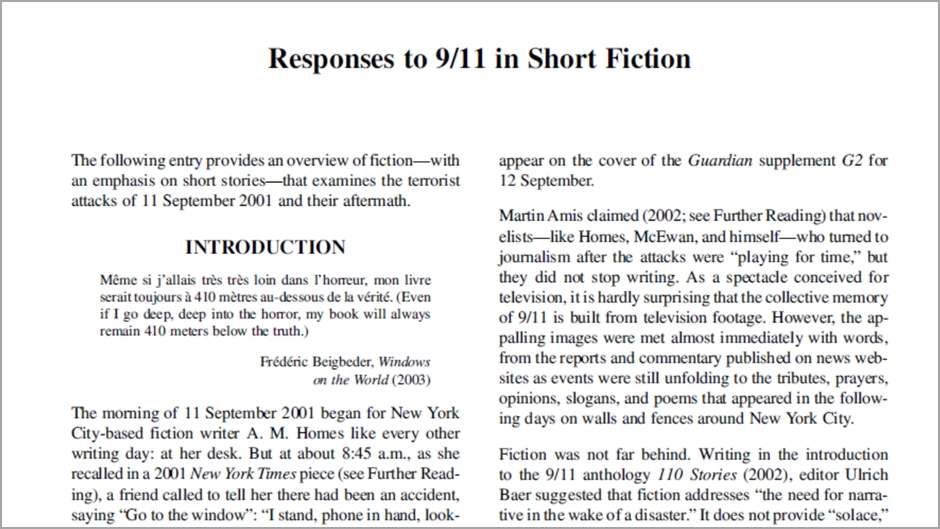| By Rebecca Parks |
I remember where I was when the planes hit the Twin Towers in New York City on September 11, 2001. I was chatting about movies with coworkers at the beginning of my workday, when someone alerted us that we needed to check out the news right away; something unimaginable was happening. One of us had a small television at their desk, and we gathered around it, watching the news coverage in disbelief. When I saw the first tower collapse, I started to sob.
My journal entry for that day began “I don’t know how to write about this day—how can I capsulate in a page or two the impact of the events which have sunk deep into my heart like a poison-tipped arrow?” Yet I did continue to write, needing the weight of the written word to bring order to my thoughts instead of the images that looped nonstop without resolution on the news channels.
I wasn’t alone in my need to write. Many fiction writers—primarily working in the short-story medium—structured stories around the events of 9/11, frequently as a way of processing the unthinkable, but often for the purpose of revealing diverse perspectives as a counter to the intense and frequently Islamophobic patriotism that arose in the aftermath of the attacks. Several of the works of these writers—including Lawrence Chua, Humera Afridi, Shauna Singh Baldwin, Sherman Alexie, Don DeLillo, David Foster Wallace, Martin Amis, William Gibson, and Phil Klay—are discussed in Short Story Criticism, Vol. 318, which includes an entry called “Responses to 9/11 in Short Fiction.”
The works covered in this volume showcase a variety of perspectives that challenge readers to view the events of 9/11 and its rippling impact in a new way. For example:
- The short story “Circumference” by Humera Afridi, a New York–based writer of Pakistani origin, chronicles the experience of a Muslim woman who takes a cab to an Islamic Center located near the wreckage of the World Trade Center just days after 9/11, describing her sense of dislocation in the midst of personal turmoil as well as the racial antagonism of the angry white New Yorkers she encounters.
- Sherman Alexie, who is a member of the Spokane Tribe of Indians, writes about a mixed-race member of the Spokane tribe who finds himself scanning airports during his business travel for “little brown guys who reeked of fundamentalism,” even though he acknowledges that he himself is “a little brown guy” in the short story “Flight Patterns.”
- Malaysian-born writer Lawrence Chua’s “The Quick and the Poor” takes the unusual approach of depicting an old man’s encounter with the painting Dead Christ by Andrea Mantegna in Milan, Italy, to critique media depictions of 9/11.
- British writer Martin Amis controversially assumed the perspective of the real-life ringleader of the 9/11 attacks in his short story “The Last Days of Muhammad Atta.”
The Amis story is excerpted in the volume as a primary source, as are the stories of British-Jamaican author Zadie Smith and Canadian lesbian writer Kelly Robson. Smith’s story, “Escape from New York,” imagines Michael Jackson, Elizabeth Taylor, and Marlon Brando escaping from New York together on 9/11, while Robson writes of a young girl distracted from the events of 9/11 by the progression of an alien infection she contracted after being raped several days before, in the story “The Three Resurrections of Jessica Churchill.”
Each of us has a story about our experience with 9/11, and this volume of Short Story Criticism shares the stories of others in a way that expands our boundaries and encourages critical thinking about these narratives.



